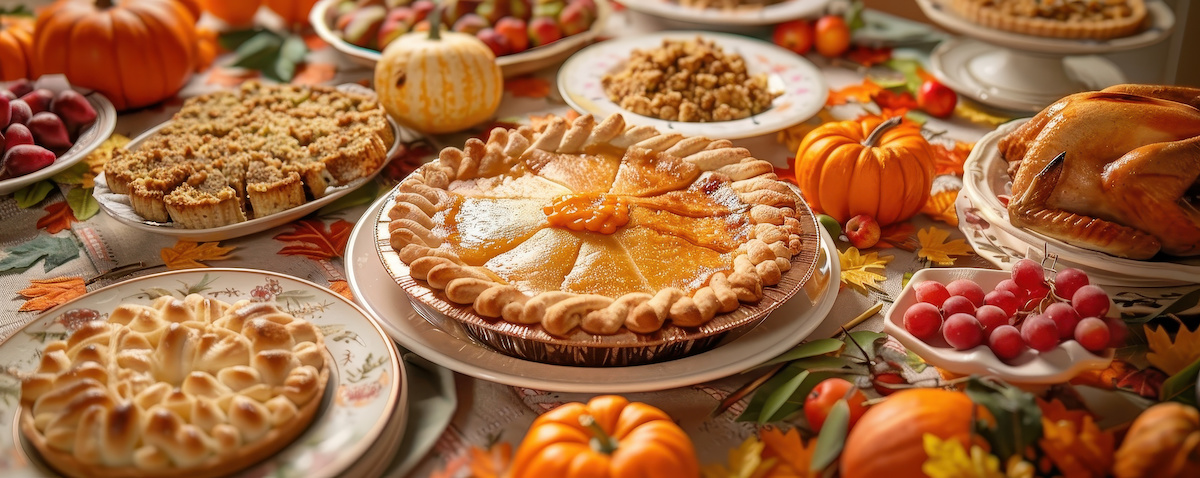Purdue Nutrition Science experts dish on holiday meal tips for guests with dietary restrictions, allergies

Purdue University Department of Nutrition Science registered dietitian nutritionists agree that communication, effort and just a few ingredient substitutions can satisfy diet restricted or allergic family and friends’ appetites during the holidays. (Adobe Stock)
Written by: Tim Brouk, tbrouk@purdue.edu
As you plan that big holiday meal, remember cousin Billy has a gluten allergy. And your nephew’s new girlfriend is vegan. And your niece can’t have dairy.
But there is no need to season that holiday dinner with extra stress when Purdue University Department of Nutrition Science experts are here. There are many ways to solve any dietary dilemma before and during a holiday gathering, according to faculty members and registered dietitian nutritionists Selena Baker and Patty Wolf.

Selena Baker
‘Shared decision making’
Baker, a registered dietitian at the Córdova Recreational Sports Center, uses “shared decision making” in her graduate-level classes she teaches. In a dietetics setting, this is an approach to common ground between dietitians and their patients. A dietitian will start with the question “What matters most to you?” to come up with a diet plan. This approach can be made with family members when designing a holiday meal menu. Does grandma’s stuffing have to have chicken broth in it, or can it be baked with vegetable broth?
“For me, stuffing is one of the dishes I absolutely have to have. If it’s a different recipe, it doesn’t count. But there are other things like cranberry sauce. If I have it, great; if I can’t have it, I’m not stressed about it,” Baker explained. “I would ask friends and family members ahead of time ‘What are some of your favorite dishes. I want to make sure that the things you really enjoy is an option that you can partake in.’”

Patty Wolf
This ensures you won’t need a “parallel menu.” If the vegan doesn’t want creamy mashed potatoes in the first place, you won’t have to whip up a dairy-free version, Baker said.
Buffet considerations
If your large gathering requires a buffet approach, Baker mentioned basics like separate serving utensils for each dish to avoid cross contamination and grouping gluten-free, vegetarian, or vegan items together and away from dishes that contain meat, dairy and/or gluten. This is essential for people with celiac disease, a chronic autoimmune disorder that damages the small intestine and prevents the body from absorbing nutrients from food.
Additionally, people with dietary allergies or restrictions should be in the front of the buffet line, lest they run out of veggie-friendly wild brown rice casserole or Italian pecan cheeseball.
“I remember when I was growing up as an ovo-lacto vegetarian, my mom was a great cook and we would bring vegetarian dishes to holiday gatherings,” Baker recalled. “The omnivores always loved the dishes and if we didn’t get through the serving line fast enough, we wouldn’t have an entrée left for us. They ate everything we could have.”
Labels or no labels?
Baker recommends labels for allergy-friendly or dietary-restricted dishes. These labels could list all the ingredients or just simply marked as “vegan” or “gluten-free.”
If there is any doubt, be sure to hang onto any food packaging labels so the guest with a gluten allergy could see for themselves what kind of ingredients are involved in a premade dish.
Wolf said flipping the traditional script could enhance things. Building a menu where most dishes are already vegan and gluten-free avoids the frantic jotting down of ingredients as well as the pressure of unsatisfied guests.
“Point to the few dishes that aren’t gluten-free and vegan rather than labeling each one. It makes people feel more included if there are way more options than ones they’re not allowed. It makes it easier for the host as well,” Wolf said. “With a complex gathering, I try to focus on a diversity of mains but then making the sides gluten-free and vegan where possible, so you don’t have to label everything. Everyone just feels comfortable eating. These days that’s fairly easy to do. … I think most people with restrictions don’t expect everyone to cater to them so then it’s like a pleasant surprise when somebody does.”
Different degrees of vegetarianism
A practicing vegetarian for most of her teens, Baker said the American vegetarian allows dairy, eggs and honey in their diet. However, vegetarians from other cultures may differ from this formula. For example, some vegetarians from India are “eggetarians” — they eat eggs but forgo dairy. Others do consume dairy but no eggs. Baker added that some Indian people that practice veganism often use the term “strict vegetarian” instead of “vegan” even though they do not eat any dairy, eggs or honey. Clarifying these specifics would show your friends or family members that you care about their diet choices, Baker said.
BTOF – bring their own food
Allowing people with food allergies or restrictions to bring their own dishes could save work and hurt feelings, Baker said. They should also bring a card or label that promotes its vegan-friendly or gluten-free nature. Again, this could be settled with some pre-holiday communication with the guest or guests.
Wolf always brings a gluten-free, vegan roasted vegetable dish with her to holiday gatherings because those veggies sometimes get overlooked during holiday meals. Ideally, everyone helps themselves to it, but she warns if the brussels sprouts is a big hit, be sure to save some in the refrigerator so the dish isn’t empty when it finally gets passed to you.
Smart substitutions
Common flavor enhancers like soy and Worcestershire sauces are among the sneakiest sources of gluten, according to Baker and Wolf. Tamari, derived from miso paste, is a good, gluten-free substitute.
While gluten-free flour is now a fairly common product in the grocery aisles, Wolf recommends blending cooked white beans, potatoes and/or butternut squash as gravy or soup thickeners. This substitution not only eliminates gluten, but it increases the nutritional value of the dish. This approach could also be used in baking that classic green bean casserole, often made with canned — but gluten-filled — mushroom soup.
Baker and Wolf agreed that communication and striving for dietary inclusion should make most eaters feel happy for the holidays.
“Most of the time just being well intentioned and asking questions and being welcoming and making that effort goes a really long way,” Baker said. “So, don’t aim for perfection, just enjoy the time together.”
Discover more from News | College of Health and Human Sciences
Subscribe to get the latest posts sent to your email.